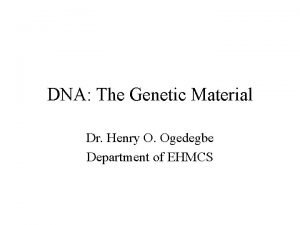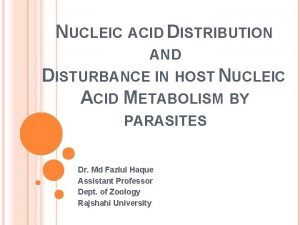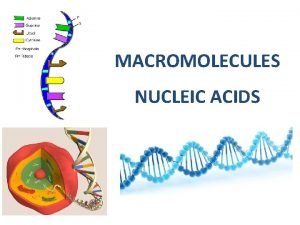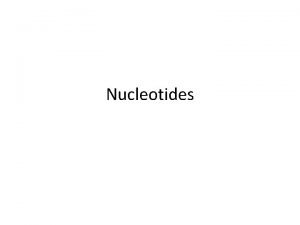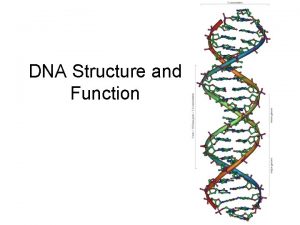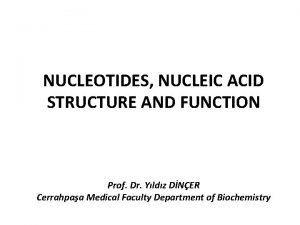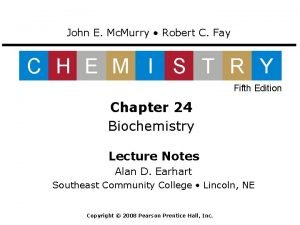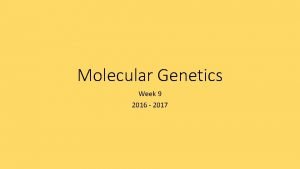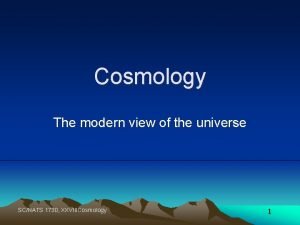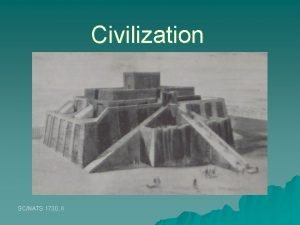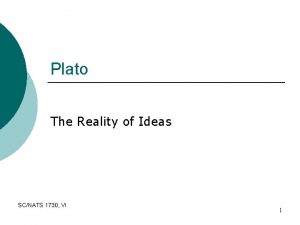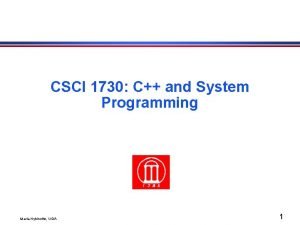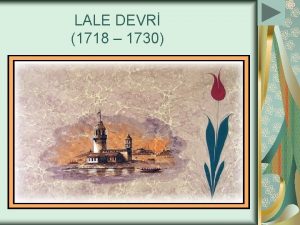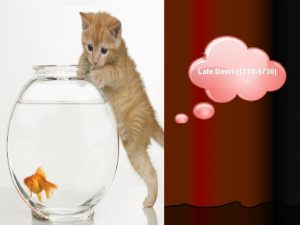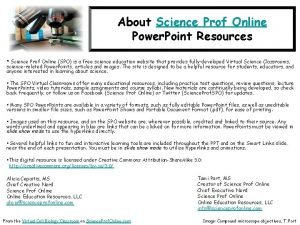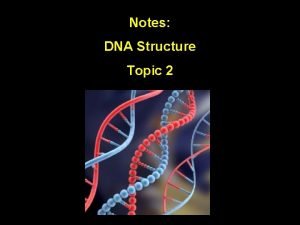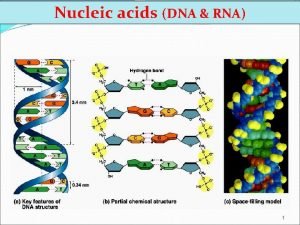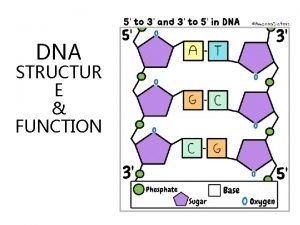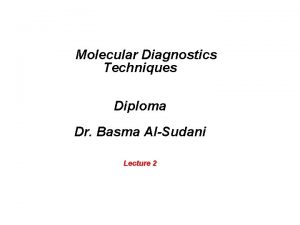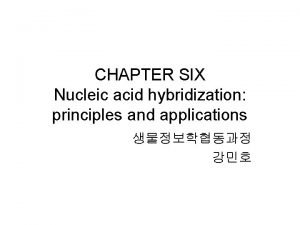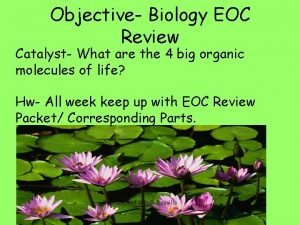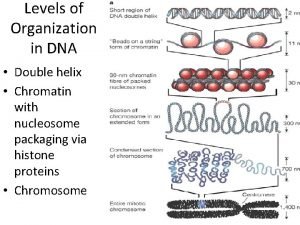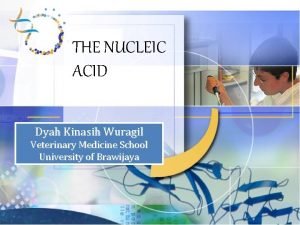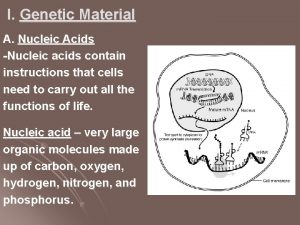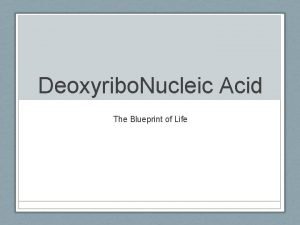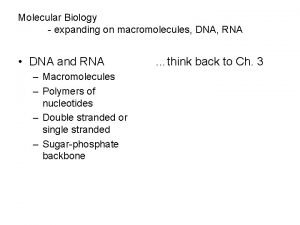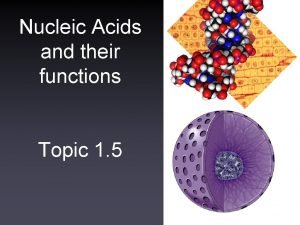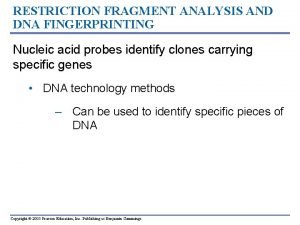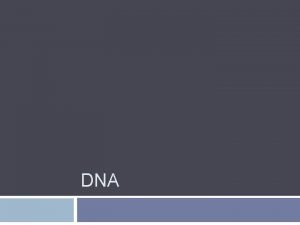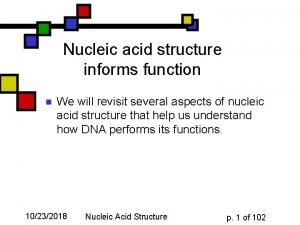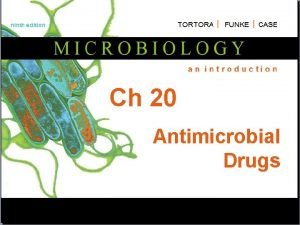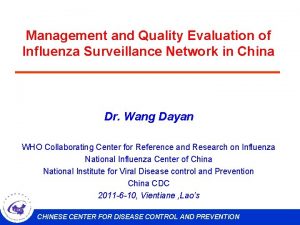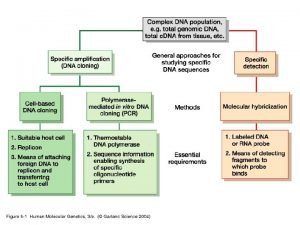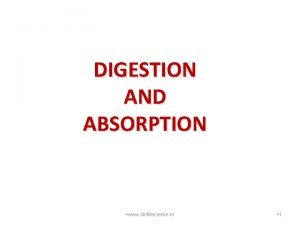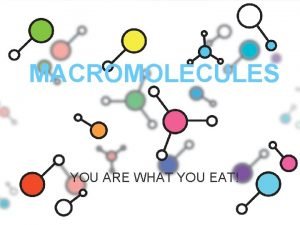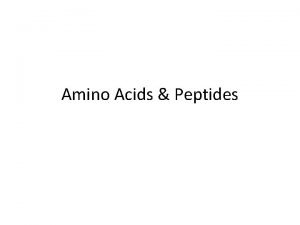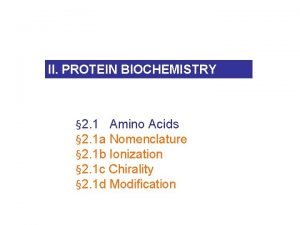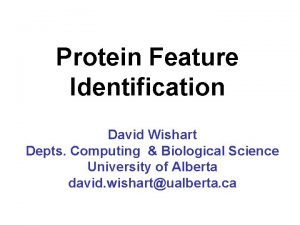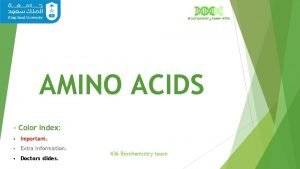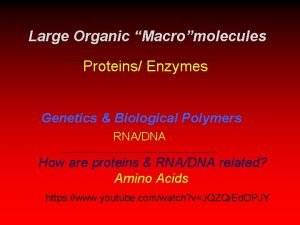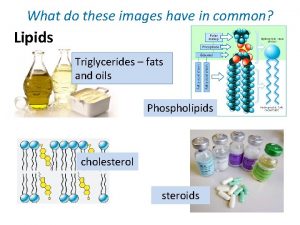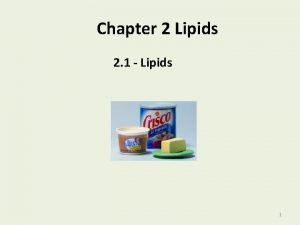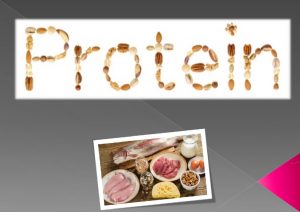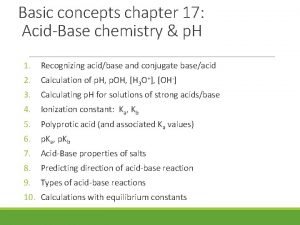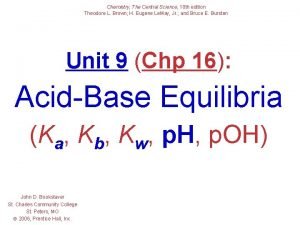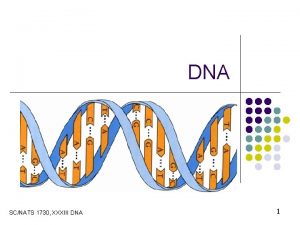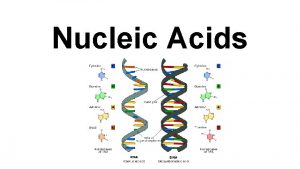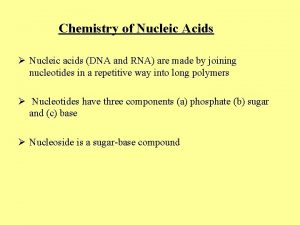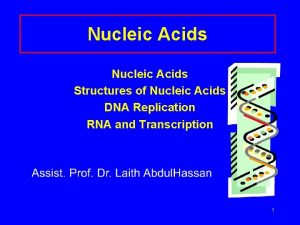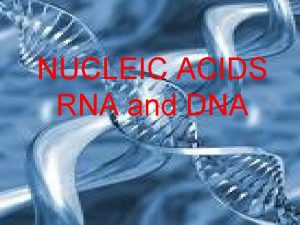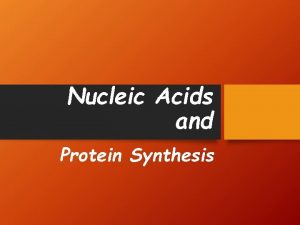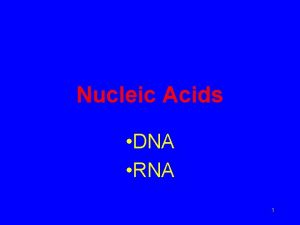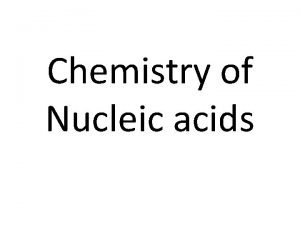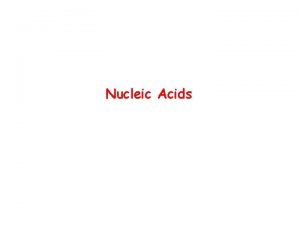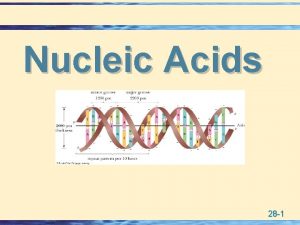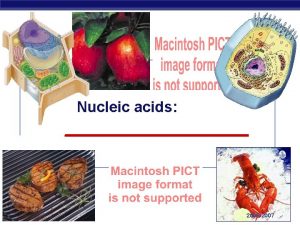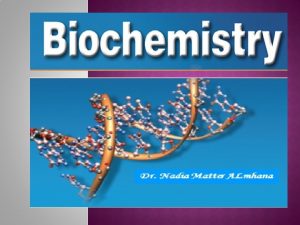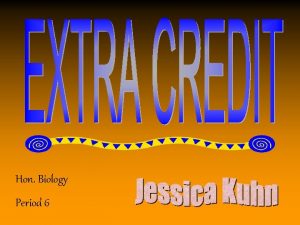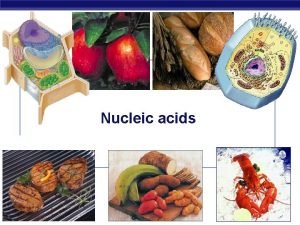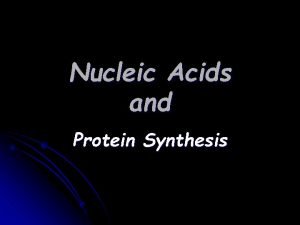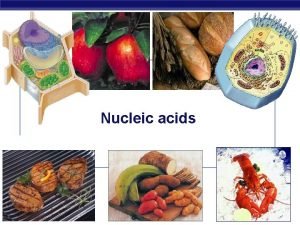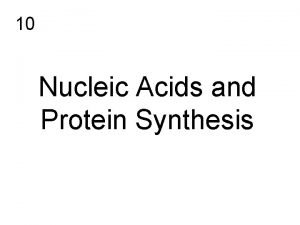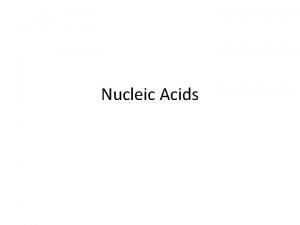DNA SCNATS 1730 XXXIII DNA 1 Nucleic Acids
























































- Slides: 56

DNA SC/NATS 1730, XXXIII DNA 1

Nucleic Acids l l In the 1860 s, Swiss chemist Friedrich Miescher discovered that cell nuclei contained acids not found elsewhere. He called these nucleic acids. By 1900, biochemists had established that nucleic acids all contained: l l l 4 nitrogenous bases, a five-carbon sugar, and molecules of phosphoric acid. SC/NATS 1730, XXXIII DNA 2

Nucleotides l Any nucleic acid it seemed could be built up from units that each contained l l one molecule of one of the bases one molecule of the 5 carbon sugar one molecule of phosphoric acid. These building block units were called nucleotides. SC/NATS 1730, XXXIII DNA 3

Polynucleotides l A complete molecule of a nucleic acid was a collection of nucleotides, or a polynucleotide for short. l l But how they are assembled was a major question. At right is a model suggested by Alexander Todd in 1951. SC/NATS 1730, XXXIII DNA 4

The 5 -carbon sugars l Any polynucleotide contains only one kind of sugar. l l The sugars found in nucleic acids are unusual in that they have 5 carbon atoms in each molecule. The usual is 6 carbon atoms. SC/NATS 1730, XXXIII DNA 5

The 5 -carbon sugars, 2 l There are two basic 5 -carbon sugars in nucleic acids: l l ribose and de-oxyribose. Note that de-oxyribose has one less oxygen atom than ribose, hence the name. SC/NATS 1730, XXXIII DNA 6

The two nucleic acids l Therefore, there are 2 kinds of nucleic acids l l l RNA – ribonucleic acid l Composed of nucleotides, each having one of four nitrogenous bases, a molecule of phosphoric acid and a molecule of ribose. DNA – deoxyribonucleic acid l Composed of nucleotides, each having one of four nitrogenous bases, a molecule of phosphoric acid and a molecule of deoxyribose. In the late 1920 s, it was discovered that DNA is found almost exclusively in the chromosomes, while RNA was actually mostly outside the nucleus, in the cytoplasm of the cell. SC/NATS 1730, XXXIII DNA 7

The nitrogenous bases l DNA has four possible bases 2 are purines l Adenine l Guanine l 2 are pyrimidines l Cytosine l Thymine RNA is similar but in place of Thymine it has a different pyrimidine, Uracil. l l SC/NATS 1730, XXXIII DNA 8

Mechanical Models l l The construction toy approach to discovering the physical structure of a complex molecule. Actual ball and stick constructions built to scale of a molecule under study, so as to get the angles and distances corresponding to physical theory. l An American innovation, derided as unscientific by most European scientists. SC/NATS 1730, XXXIII DNA 9

Linus Pauling and Mechanical Models l Linus Pauling at the California Institute of Technology was the leader in this work. l His book The Nature of the Chemical Bond was the standard text in the field. l In 1951, Pauling discovered the basic structure of many protein molecules (polypeptides) by building such 3 dimensional models. SC/NATS 1730, XXXIII DNA 10

Alpha-helix model. l l One of Pauling’s major discoveries was the alphahelix structure of many proteins. So called because, he learned, the molecular chain continually crossed over on itself, making the shape of the Greek letter alpha, , and then twisted into the coil shape of a helix. SC/NATS 1730, XXXIII DNA 11

Chargaff’s Rules l One of the interesting discoveries, coming right out of standard chemical research methods concerned the makeup of DNA. l In DNA samples, the relative amounts of sugar, phosphates, and bases was constant. l l Every nucleotide had one of each. But there were 4 different bases, and their amounts varied widely. SC/NATS 1730, XXXIII DNA 12

Chargaff’s Rules, 2 l Erwin Chargaff, a chemist at Columbia University in New York discovered in 1950 that: l l l The amount of guanine = the amount of cytosine The amount of thymine = the amount of adenine. These are called Chargaff’s rules. Erwin Chargaff SC/NATS 1730, XXXIII DNA 13

The Gene: Protein or Nucleic Acid? l In 1944, Oswald Avery fed DNA from donor bacteria to recipient bacteria. l l Some of the recipients then began to function like the donor bacteria. Therefore Avery concluded that the DNA had transmitted hereditable information. SC/NATS 1730, XXXIII DNA 14

The Gene: Protein or Nucleic Acid? , 2 l In 1952, Martha Chase and Alfred Hershey (of the Phage Group) did more experiments and showed that only the DNA of a phage had infected a bacterial host, with similar results. l SC/NATS 1730, XXXIII DNA was therefore much more strongly indicated as the likely carrier of the genes. 15

Crystallography – X-Ray Diffraction l. W. l L. Bragg l. W. H. Bragg W. H. Bragg and W. L. Bragg, father and son, invented the discipline of crystallography in 1912. l They used it to study the structure of many simpler crystallized structures. SC/NATS 1730, XXXIII DNA 16

Crystallography – X-Ray Diffraction, 2 l Britain was the center of crystallography in the twentieth century. l W. L. Bragg, the son, was the head of the Medical Research Division of the Cavendish Laboratories at Cambridge in the 1950 s, which was one of the main research centres in crystallography SC/NATS 1730, XXXIII DNA 17

Crystallography – X-Ray Diffraction, 3 l Another was King’s College at the University of London. l At King’s, the head crystallographer was Rosalind Franklin, who was studying the structure of DNA using x-ray diffraction. SC/NATS 1730, XXXIII DNA 18

James D. Watson l l l. James Watson l l Born in Chicago, took a biology degree from the University of Chicago at age 19. Did his graduate studies at Indiana University under Salvador Luria, one of the original Phage Group. Watson completed his Ph. D. in 1950 at age 22. l l. Watson 1928 – Luria admitted him to the select Phage Group. & Luria SC/NATS 1730, XXXIII DNA 19

Watson in search of the gene l l l Watson’s main scientific interest was to discover the nature of the gene. He continued his research with a post-doctoral fellowship in Copenhagen, doing work on phages, and learning some biochemistry. While attending a conference in Naples, Watson heard a talk by Maurice Wilkins of Kings College, London, on x-ray diffraction photos of DNA. SC/NATS 1730, XXXIII DNA l. Maurice Wilkins (1916 -2004) 20

Watson wants to learn about xray diffraction l l Watson talked to Wilkins about x-ray diffraction of DNA. He learned that there was much work going on at the interdisciplinary medical research division of the Cavendish Laboratories at Cambridge University. l With Luria’s help, he obtained a post-doctoral fellowship at the Cavendish, where he arrived in 1951. SC/NATS 1730, XXXIII DNA 21

Francis Crick l l Originally trained in physics, Crick interrupted his studies to work for the military during World War II. l l 1916 – 2004 After the war, Crick decided to turn to biology. He was enrolled in the Ph. D. program at Cambridge University and doing his work at the Cavendish Laboratories when Watson arrived in 1951. l Crick was then 35 years old. SC/NATS 1730, XXXIII DNA 22

What is Life? l Erwin Schrödinger’s 1944 book, What is Life? , was the inspiration for several young physicists during and just after World War II, who radically changed their careers from physics to biology. l l Schrödinger showed how the intellectual apparatus of physics could be applied to issues in biology. Among these were Maurice Wilkins and Francis Crick. SC/NATS 1730, XXXIII DNA 23

Watson and Crick l Watson and Crick became friends almost immediately. l l They both had a special interest in DNA. They had radically different backgrounds and different areas of expertise. They had sharply different personalities. The complemented each other perfectly. SC/NATS 1730, XXXIII DNA 24

Multi-disciplinary approach of Watson and Crick l l Watson was a biologist. Crick had solid training in physics Working at the Cavendish, they were able to use techniques from several disciplines and to share their ideas with specialists in other areas, who could be of help to them. They were the perfect illustration of the advantages offered for cooperative work at the multi-disciplinary Cavendish Laboratories. SC/NATS 1730, XXXIII DNA 25

The search for the structure of DNA l At the Cavendish, both Watson and Crick had major projects which were supposed to occupy most of their time. l l l Watson was supposed to be learning the fundamentals of x -ray diffraction crystallography. The Cavendish was the place to be doing that. The Medical Research Division was headed up by W. L. Bragg, who, with his father, practically invented the field. Crick was working on his Ph. D. dissertation. Nevertheless, their common interest in DNA kept bringing them back to that and trying out new ideas. SC/NATS 1730, XXXIII DNA 26

Developments elsewhere l Watson and Crick were spurred on by the work emerging from other research centres and were quick to follow up on new developments. l In 1951, Linus Pauling discovered the -helix structure of proteins using molecular models. l In 1952, Martha Chase and Alfred Hershey established that DNA was probably the carrier of heredity, not protein. SC/NATS 1730, XXXIII DNA 27

Developments elsewhere, 2 l More developments: l At King’s College, London, Rosalind Franklin had taken some crucial x-ray photos of DNA that strongly suggested that the structure was helical. The stepped cross sign in this photo of DNA was characteristic of a helical structure. SC/NATS 1730, XXXIII DNA 28

Developments elsewhere, 2 l Erwin Chargaff came to Cambridge in 1952 to give a talk, attended by Watson and Crick. l l He mentioned “Chagaff’s Rules” – that in a DNA sample, the amount of guanine equals the amount of cytosine and the amount of adenine equals the amount of thymine. Though both Watson and Crick had heard of these rules before, Chargaff’s visit put them back in the forefront of their minds. SC/NATS 1730, XXXIII DNA 29

Serious model building l l In fits and starts, Watson and Crick sorted through different ideas about the structure of DNA. Finally in April, 1953, with the benefit of foreknowledge of Rosalind Franklin’s x-ray pictures and Chargaff’s rules, they began using Linus Pauling’s model building technique to try to construct a 3 -dimensional model of DNA that would fit all they already knew. SC/NATS 1730, XXXIII DNA 30

Fitting Chargaff’s Rules l. Thymine l l bonded to Adenine l. Cytosine bonded to Guanine As Crick said later, it should have been obvious that Chargaff’s rules implied that the bases that were equal in number somehow go together. What he found was that they did. SC/NATS 1730, XXXIII DNA 31

The satisfactory model l l The model they built fit Rosalind Franklin’s pictures, incorporated Chargaff’s rules as an essential feature, and satisfied all the requirements of physical chemistry as to bond angles and distances. They called Wilkins and Franklin at King’s College, who came to inspect and approve the model. SC/NATS 1730, XXXIII DNA 32

Publication in Nature l Their results his the scientific world as a bombshell in the form of three papers in the journal Nature on April 25, 1953. l l l This date, 1953, is the 8 th and last date you must remember in this course. The first paper was Watson and Crick’s description of their mechanical model. The second was by Maurice Wilkins and his associates, and the third was by Rosalind Franklin and her assistant. l The 2 nd and 3 rd papers provided the data that were satisfied by the Watson-Crick model. SC/NATS 1730, XXXIII DNA 33

The Structure of DNA l The main issues of DNA structure that were solved by Watson and Crick: l l l It had a helical structure. It had two strands (a double helix). The backbone of the strands was on the outside of the molecule, and the strands pointed in opposite directions. l The x-ray work by Rosalind Franklin confirmed these conclusions. . SC/NATS 1730, XXXIII DNA 34

The Structure of DNA, 2 l The arrangement of the bases: l The strands are held together by bonds between the bases on opposing strands. Guanine bonds with Cytosine l Adenine bonds with Thymine l This is consistent with Chargaff’s rules. § The G-C or A-T combinations could be turned either way and would all fit in the same space. l SC/NATS 1730, XXXIII DNA 35

Molecular Biology l l Biology has not been the same since April 25, 1953. Almost every aspect of biology is affected by our understanding of DNA. Research in DNA and related matters has become the core of biology. A new branch of biology, molecular biology, began at that time. l It investigates biological functions at the molecular, i. e. , chemical, level, starting from the understanding of how the DNA molecule – and the related RNA molecule – accomplish what they do. SC/NATS 1730, XXXIII DNA 36

The Central Dogma l The Central Dogma (as it is called) of molecular biology, as formulated by Watson and Crick on how DNA controls heredity: l There are two separate functions: l The Autocatalytic function is how DNA reproduces itself. l The Heterocatalytic Function is how DNA controls the development of the body – how it conveys its genetic information to the rest of the body. SC/NATS 1730, XXXIII DNA 37

The Autocatalytic Function l l l The DNA molecule is the direct template for its own replication. During cell division, the DNA double helix uncoils, separating at the purine-pyrimidine bond. A new strand forms matching the corresponding bond at the purine or pyrimidine base with the same complementary base that had been attached there before. SC/NATS 1730, XXXIII DNA 38

The Autocatalytic Function l l Thus each strand of DNA produces not a copy of itself, but a copy of its complement, which then coils back together making two identical DNA molecules. Mutations are errors in this copying function. If the template is not copied correctly due to, say, radiation interference or chemical imbalance, the resulting molecules of DNA are not the same as the original. l The base pairs are very similar to each other. A G-C combination is almost identical to an A-T combination. It would take only a slight dislocation of a bond to change one into another. SC/NATS 1730, XXXIII DNA 39

The Heterocatalytic Function l When the body determines that it requires more of something (e. g. a protein) in a cell, an enzyme is secreted into the cell nucleus, which causes the DNA molecule to open up at a specified place, breaking the bonds between the purines and pyrimidines. SC/NATS 1730, XXXIII DNA 40

The Heterocatalytic Function, 2 l l At the place where the DNA is open, enzymes cause a backbone of ribose and phospate to form and attract to it the purines and pyrimidines that are the complements of the exposed bases on the DNA. This forms a piece of RNA (which is single stranded). The piece of RNA that has formed and copied the sequence of bases onto its own molecule then migrates out of the nucleus into the cytoplasm, where it becomes the template for protein synthesis. This piece of RNA is called messenger-RNA or m. RNA for short. SC/NATS 1730, XXXIII DNA 41

Codons l There are four different bases that form the sequences in DNA. l l l Think of this as an alphabet with four letters A C G T. The sequence of these “letters” on a stretch of DNA is transferred to messenger RNA. l Actually the complement of the sequence is transferred, with Uracil substituting for Thymine. In any case it is still a sequence written in four letters. Proteins are made up of strings of amino acids. l l There are twenty amino acids that go into proteins. The sequences of bases on the m. RNA determine which amino acid goes next in the sequence on a protein when it is being formed. SC/NATS 1730, XXXIII DNA 42

Codons, 2 l l To make four “letters” point to 20 different amino acids, they are grouped in threes. Each group of three bases is called a codon. Since there are 4 bases to choose from for each “letter” of the codon “word, ” there are 64 possible codons: l 4 x 4 = 64 SC/NATS 1730, XXXIII DNA 43

Codons, 3 l Each codon points to a particular amino acid. l Since there are 64 codons and only 20 amino acids, several codons point to the same amino acid. SC/NATS 1730, XXXIII DNA 44

Protein Synthesis l The actual process for protein synthesis is as follows: l l m. RNA travels to the cytoplasm where it meets ribosomes. The m. RNA passes through each ribosome, where each codon is “read” and matched with a piece of transfer RNA (t. RNA), which is specific to that codon. The t. RNA brings with it the amino acid that corresponds to the particular codon. A process in the ribosome causes the t. RNA to latch on to the m. RNA and then release the amino acid to be added to the string of amino acids of the protein under construction. SC/NATS 1730, XXXIII DNA 45

One Way Process l In the general course of DNA-body interactions, information flows from the DNA, to the body, not vice-versa l l l There is no mechanism here to support the inheritance of acquired characteristics. Changes in the environment of an individual would not affect that individual’s DNA. The DNA therefore is much like Weismann’s germ plasm. l Except: Newly discovered retroviruses can affect the DNA, leaving the door partly open on the question of inheritance of acquired characters. SC/NATS 1730, XXXIII DNA 46

Recombinant DNA l l l The complexity of DNA has made it very difficult to study its particular sequences in detail. Even a virus can have as many as 5000 base pairs. A human has more like 100, 000 base pairs in its DNA. Breakthroughs in research came in the mid 1970 s with two techniques for working with DNA. SC/NATS 1730, XXXIII DNA 47

Recombinant DNA l Cleaving enzymes – that have the effect of cutting a piece of DNA wherever it encounters a certain sequence of bases. l l l For example the enzyme ECORI cuts DNA at the sequence GAATC. DNA ligases are other enzymes discovered that rejoin DNA pieces. Thus DNA research had the “scissors” and “paste” tools necessary to manipulate DNA and study the results of experiments. SC/NATS 1730, XXXIII DNA 48

Cloning l Cloning is the process of producing a strain of DNA and then inserting that DNA into a host where it will replicate. The replicated DNA is called a clone. l l Cloning as a technique has many uses. For example, it can be used to replicate rare hormones and proteins such as insulin and interferon that have much medical usage. Recently cloning has been taken to far a far greater extent. Whole organisms have been reproduced from DNA taken from other bodies. SC/NATS 1730, XXXIII DNA 49

Insulin l Insulin is a protein hormone produced in the pancreas that the body uses to regulate blood sugar concentrations. l l Diabetics have lost the ability to produce insulin and must have an outside source of it. In the 1920 s, insulin from cows and pigs was isolated and made available to humans with diabetes. (Though it is not identical to human insulin. ) Supply was a major concern since the number of diabetics was on the rise. Cloning insulin became an ideal usage for recombinant DNA technology. SC/NATS 1730, XXXIII DNA 50

The Manufacture of Insulin by Cloning l l l In 1978, Herbert Boyer and colleagues at the University of California in San Francisco created a synthetic version of human insulin using recombinant DNA technology. The DNA sequence representing the instructions on growing insulin was separated and then inserted into the bacterium E. coli. The E. coli then produced prodigious amounts of human insulin. SC/NATS 1730, XXXIII DNA 51

Cloning Whole Animals l In 1997, the sheep “Dolly” was cloned from an adult sheep. Dolly is an exact replica of its “mother” – the animal from which the cell was taken. SC/NATS 1730, XXXIII DNA 52

Stem Cells l l Most cells in the body of an adult animal are specialized cells, which have the capacity only to reproduce themselves. Cells that have the ability to divide and give rise to different kinds of specialized cells are called stem cells. SC/NATS 1730, XXXIII DNA l. Stem cells 53

Stem Cells l At conception, the fertilized egg is a stem cell capable of dividing and becoming every different kind of cell in the adult body. l They are “Totipotent. ” In humans, the cells that are produced in the first four days or so after conception are all totipotent stems. At later embryonic stages and even in the grown adult, there are stem cells with limited potential to grow into different kinds of cells. l l l These are called “Pluripotent. ” SC/NATS 1730, XXXIII DNA 54

Stem cells, 2 l The medical potential of stem cells, both the totipotent and pluripotent is enormous. l l l If stem cells can be isolated, cultured, and then grafted into patients, many degenerative diseases could possibly be reversed. Cells generated from a patient’s own stem cells, for example, would not be rejected by the body the way that the cells of donor organs often are. Stem cells could be used to regenerate brain and nerve cells, possibly heart muscle, and many other possible uses. SC/NATS 1730, XXXIII DNA 55

Ethical issues in Biotechnology l There are ethical issues all the way along in biotechnology because human beings are capable of manipulating life as never before. l l l Stem cell research raises the issue of where life begins and whether cells from a human embryo should be used for another human’s benefit. Present stem cell work concentrates on making regenerative cells for the cure of diseases. But the possibility of cloning whole human beings has to be considered. l Dolly was cloned from a stem cell. SC/NATS 1730, XXXIII DNA 56
 Functions of nucleic acid
Functions of nucleic acid Nucleic acid made up of
Nucleic acid made up of Nucleic acid
Nucleic acid Building block of nucleic acid
Building block of nucleic acid Nucleotide nomenclature
Nucleotide nomenclature Biological importance of nucleotides
Biological importance of nucleotides Food rich in nucleic acid
Food rich in nucleic acid Nucleic acid monomer
Nucleic acid monomer Nucleotides function
Nucleotides function Hystonia
Hystonia Nucleic acids
Nucleic acids Importance of nucleic acid
Importance of nucleic acid Store and transmit hereditary
Store and transmit hereditary Nucleic acids concept map
Nucleic acids concept map Scnats
Scnats Scnats
Scnats Sensible world
Sensible world Maria hybinette
Maria hybinette 1718 1730
1718 1730 1718 1730
1718 1730 Nucleic acid dna structure
Nucleic acid dna structure Dna structure
Dna structure Nucleic acid
Nucleic acid Chargaff's rule
Chargaff's rule Types of nucleic acid
Types of nucleic acid Nucleic acid hybridization principle
Nucleic acid hybridization principle Nucleic acid monomer
Nucleic acid monomer Synapsis
Synapsis Kalju kahn
Kalju kahn Nucleic acid made up of
Nucleic acid made up of Nucleic acid
Nucleic acid Nucleic acid chart
Nucleic acid chart Nucleic
Nucleic Restriction fragment analysis
Restriction fragment analysis Dideoxyribonucleic
Dideoxyribonucleic Nucleic acid
Nucleic acid Inhibition of nucleic acid synthesis
Inhibition of nucleic acid synthesis Nucleic acid test
Nucleic acid test Nucleic acid
Nucleic acid Digestion of nucleic acid
Digestion of nucleic acid Biological molecules you are what you eat
Biological molecules you are what you eat Infectious nucleic acid
Infectious nucleic acid Coding dna and non coding dna
Coding dna and non coding dna Function of dna polymerase 3
Function of dna polymerase 3 The principal enzyme involved in dna replication is
The principal enzyme involved in dna replication is Bioflix activity dna replication lagging strand synthesis
Bioflix activity dna replication lagging strand synthesis Dna and genes chapter 11
Dna and genes chapter 11 Biomedical importance of amino acids
Biomedical importance of amino acids Aromatic amino acids
Aromatic amino acids Charged amino acids
Charged amino acids Essential aa mnemonic
Essential aa mnemonic 20 amino acids structures
20 amino acids structures What do these images have in common
What do these images have in common Glyceryl tripalmitate saponification
Glyceryl tripalmitate saponification What is made of amino acids
What is made of amino acids Acid base trends
Acid base trends Six strong acids
Six strong acids
